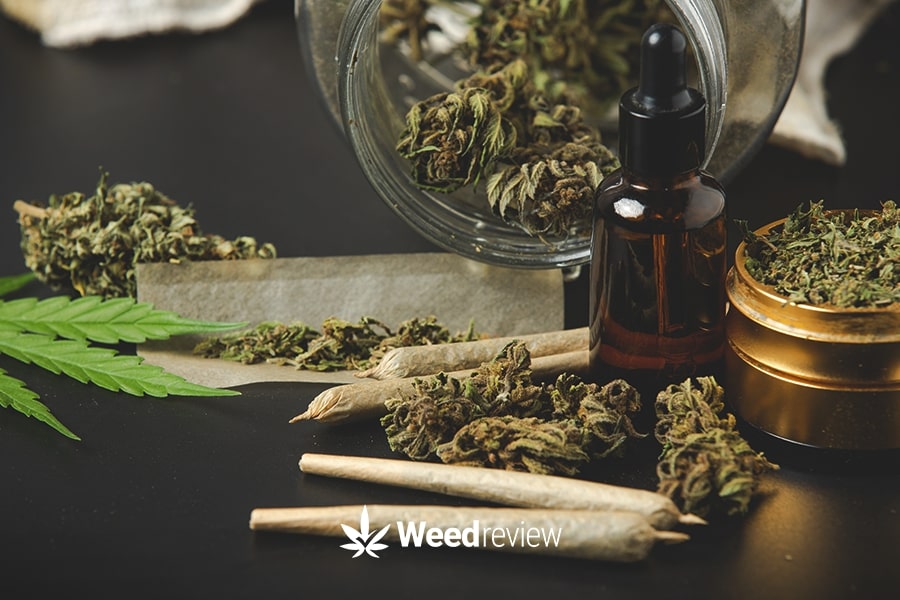
Step-by-Step Guide on How to Roll a Joint: A Look into Papers, Tips, and Rolling Technique

Table of Contents
Rolling a joint is a skill cherished by cannabis enthusiasts around the world. Whether you’re a beginner or looking to perfect your rolling technique, this step-by-step guide will walk you through the process of rolling a classic joint.
From selecting the right rolling papers to mastering the art of rolling and sealing, we will help you become an expert in making joints.
What you will need to roll a joint
You don’t need much to roll a joint:
- Filter tip/joint tip
- Rolling paper
- Grinder
- Cannabis flowers
- A small stick to stuff the flowers
- A small plate or a clean area to roll the joint
How to choose the right rolling papers
Cannabis dispensaries carry a huge inventory of rolling papers. There are many brands to choose from – each with different sizes and materials. Popular brands include OCB, Raw, and Elements.
Sizes
There are several sizes to choose from. You should get the one that fits the amount of weed you want to use.
Ideally, solo smokers will generally stick to single wide for casual use and double wide for thicker joints.
- Single wide: Among the smallest rolling paper sizes, single wide papers typically measure around 68-70mm in width. These are perfect for crafting small cannabis cigarettes, making them an excellent choice for solo smokers seeking casual and personal smoke.
- King-size: Larger than single-wide papers, king-size rolling papers usually measure around 100-110mm in width. They offer ample space for rolling larger joints, making them a popular choice for those who want a longer and stronger smoking experience.
- Double wide: For those occasions when you’re sharing the moment with friends, double-wide rolling papers step up the game. Measuring around 125-130mm in width, they are suitable for crafting extra-large joints, ensuring there’s enough to pass around and enjoy together.
- King slims: If you appreciate the length of king-sized rolling papers but prefer a thinner joint, king slims are the solution. These papers maintain a length of 100-110mm while slimming down to a width of 44mm, providing a balanced compromise between length and thickness.
You will also find readymade joint papers, also known as pre-roll cones or just cones. These come already rolled and assembled with the filter tips. All you have to do is stuff the flower, and you are good to go!
Materials
The material of your rolling paper will determine the burn time of your joints and the cleanness of the smoke.
Here are the most common rolling paper materials that you will find on the market today:
- Bamboo: Made from bamboo fibres, these papers burn slowly and offer a natural taste. They’re eco-friendly and often unbleached for cleaner smoke.
- Hemp: Crafted from hemp plant fibres, these papers are natural and organic. They burn slowly, allowing you to enjoy the flavour of the strain fully.
- Rice: Ultra-thin and lightweight, these papers burn cleanly and evenly.
- Flax: A mix of flax fibres and wood pulp, these papers provide a smooth burn while still showcasing your flower’s taste.
Opt for unbleached varieties to minimise exposure to harmful chemicals. Consider your preferences for burn time, flavour, and environmental impact when making your choice.
Each material brings something new to the table; explore different options to find the perfect match for your smoking style.
Flavours
Flavoured rolling papers offer an exciting twist to the traditional joint-rolling process, infusing your smoking experience with delightful and aromatic notes. These papers are designed to enhance the taste and aroma of your chosen smoking material, providing a unique and enjoyable toke.
Commonly found flavours are vanilla, strawberry, mango, blueberry, chocolate, and mint.
Flavoured rolling papers encourage experimentation, allowing you to pair different flavours with different marijuana strains.
Choose a flavour that complements the features of your cannabis bud instead of completely overpowering the taste. For instance, a citrus-flavoured paper could enhance the zestiness of strains like Sour Diesel.
Filter tips
There are various types of joint tips available, each with its unique advantages.
- Paper filter tips: Paper filter tips, often made from sturdy cardstock or similar materials, provide structural support to the joint. They help maintain the shape of your joint while preventing loose bits of herb from being inhaled.
- Charcoal filter tips: Charcoal tips take filtration a step further by using activated charcoal to absorb impurities and tar from the smoke. This results in a cleaner, smoother draw and a reduction in harshness.
- Hemp filter tips: These are like paper filter tips, except they are made from hemp fibres. Hemp joint tips offer a natural and eco-friendly choice.
- Glass filter tips: Glass filter tips offer a unique, luxurious experience. They help lower the temperature of the smoke, providing a smoother and less harsh draw. Additionally, they are easy to clean and can be used repeatedly. Note that you will have to stuff the rolled joint into the slot provided instead of rolling the paper around it.
How much weed should go in a joint?
For beginners, start with a small dose and slowly increase it over time. Start by adding a quarter to half a gram of crushed bud mixed with tobacco to ensure smooth burning.
The amount you add also depends on the quality of the cannabis flower.
“Top-shelf” or high-quality weed offer a superior flavour and stronger potency than other grades of weed. With these potent strains, you can enjoy the high with smaller amounts. For example, with AAA bud of Northern Lights, you need less than half a gram to get a good joint.
With lower-quality flowers or brick weed, you might more to get the same kind of smoking experience.
How to roll a joint
There are six simple steps to rolling a classic joint. Pay close attention when rolling it, as you want the paper to be tight so that airflow is directed through the joint.
Grind your nugs

Use a grinder to break down your nugs to be rolled. It helps keep your hands from getting sticky with resin and ensures that the joint burns evenly.
Make the filter
You can use store-bought filter tips, or you can make them out of stiff pieces of paper like a business card or pieces of the rolling paper pack.
The first step is to make three to four alternate folds at one end of the filter paper to give it an accordion shape.

After the folds, roll it up into a cylindrical tube. You know you’ve done it correctly if there is an “M” in the middle of your filter when you look through it.
Fill the rolling paper with weed
Spread the rolling paper such that the sticky glue side is facing you. Curve the paper from two ends so that it makes a little ditch in the centre.

Place your filter at one end of the rolling paper. Then, spread your weed evenly on the paper.
Rolling and sealing
Place your thumbs and forefingers near the ends of the paper. Gently move your fingers back and forth to guide the weed into a compact cylinder shape. This helps evenly distribute the weed and create a solid joint.
Once the weed is shaped, tuck one side of the paper into the roll using your thumbs. This secures the weed inside.

Then, lick the sticky part, and press it against the tucked side. The moisture from your saliva acts like glue and seals the joint.
Pack and twist
This step is optional. Take the small stick and gently tap through the open end of the joint to stuff the cannabis. Now that your joint has taken shape, you can add the remaining ground bud to pack the cannabis cigarette fully.
The last bit to do is close the joint. Twist the open end to seal it, and it’s ready to smoke.
Effects and duration of smoking a cannabis joint
The onset of effects from a cannabis joint typically occurs within minutes after smoking. The euphoric effects of weed generally last between one and three hours.
This stands in contrast to oral consumption methods, like edibles, which can take up to an hour or two due to digestion.
The effects can be different from person to person due to factors like the potency of the cannabis strain, individual tolerance levels, and the amount of weed used.
The risks of smoking
Smoking joints can have some side effects that affect respiratory functionality. Symptoms generally apply more strongly to those who frequently smoke and will see repeated occurrences of bronchitis.
Other side effects can include:
- Coughing
- Dry mouth
- Nausea
- Wheezing
- Phlegm buildup
- Increased risk of respiratory infections
It is possible to negate some of these side effects by using charcoal filter tips. These ‘clean’ the smoke greatly, resulting in a smoother toke and fewer breathing problems.
If you have any concerns about your breathing, it is best to consult your doctor before smoking a joint.
Conclusion
Rolling a joint is like creating a little masterpiece for your smoke. With practice, you’ll craft joints just the way you like them. Don’t worry if rolling a joint feels a bit tricky at first. With some patience, you’ll get the hang of it and be rolling joints like a pro.
Feel free to experiment with different types of papers and filter tips to keep things exciting. Happy toking!


